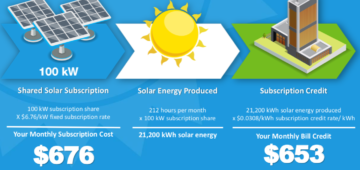Shared solar power has an important role to play in Florida's clean energy future. FPL will be filing its shared program for approval in March 2019. How does it work and does it provide customer value?
George Cavros | January 3, 2019 | Florida, SolarIt’s a great time in Florida to take advantage of the economic benefits of solar power. Solar costs continue to drop, the federal investment tax credit is available for qualified solar investments, and the net metering rule for investor-owned utilities provides a fair credit for excess energy produced by solar customers.
Both utility-scale and rooftop solar continue to grow in Florida. Yet, a number of customers can’t directly take advantage of rooftop solar power. They may lease their homes, live in multi-tenant dwellings, have roofs that can’t host a solar system or have too much shade, or experience other mitigating factors. Shared (or community) solar programs are intended to provide access to the economic benefits of solar power to those customers. Shared solar refers to a solar facility that is shared by multiple customers who receive credit on their electricity bill for their share of the produced power. In Florida, since only a utility can sell power directly to a customer, the shared solar programs are utility-sponsored programs.
Florida Power and Light (FPL), the state’s largest power company, is pre-registering commercial and municipal customers in a program called SolarTogether, which FPL intends to file with the Florida Public Service Commission (PSC) in March 2019. The pre-registration is intended to gauge interest in the program. The program once approved, will also be open to residential customers.
How does it work?
FPL has not yet provided full details. For example, it hasn’t publicly released how it arrived at the subscription costs or customer credits for the program – that information should come when it files the program with the PSC. But, based on the information the Company has provided on its website, and subject to approval by the PSC, we expect the following: 
- Participants can subscribe to blocks of a solar facility to be built – up to 100% of their historical energy use
- A fixed monthly subscription fee of $6.76 per kW block will apply and the bill will also reflect a credit of 3.08 cents per kWh for energy produced from your subscribed kW block.
- The bill credit rate will increase annually if you remain in the program. According to the Pre-Registration Agreement for commercial customers, that escalation factor is projected at 1.45% per year.
- The monthly cost of the kW block is projected to exceed the monthly credit in the early years, but in later years the credit is projected to exceed costs. FPL estimates a customer’s simple payback period will be 5 to 7 years. The solar “investment” will not change customer rates. Both the program cost and the credit will appear as line items on customer bills.
- FPL provides an illustrative example above of what a 100 kW block customer might expect to pay in costs and receive in credits per month after they initially join the program.
Tangible economic benefit; customer value drive success
A core design principle of a successful shared solar program is that it provides a tangible economic benefit on electricity bills that is a fair value proposition to customers participating in the program. This has not been the case with several shared solar, or community-themed programs rolled out in the past in Florida. The first one rolled out in 2015 by Gulf Power, proposed an annual subscription rate of $99 for minimal participation in the program and provided about $24 in an annual bill credit. In 2017, the PSC approved a similarly designed program for Duke Energy Florida. The FPL SolarNow program introduced in 2014 has a community-themed title and is based entirely on donations; providing no tangible economic benefit to participating customers.
Nonetheless, there have been several programs rolled out recently that provide tangible economic benefits and considerably more customer value. The first is a popular shared solar program by the City of Tallahassee that provides the opportunity for customers to purchase solar at the energy rate at 5 cents per kWh in lieu of the natural gas fuel charge on their bill. The rate can be locked in for 20 years – providing an effective hedge against rising fuel prices on customer electricity bills. The first 20 MW has sold out, and the City is constructing another 40 MW to meet demand. Tampa Electric has filed a similarly designed program for approval at the PSC.
Another important aspect is that shared solar programs should complement existing programs and not undermine them. Shared solar is about expanding access to solar to additional customers. FPL and the investor-owned utilities have successful net metering programs. It remains to be seen how the FPL program will be received, and the devil is in the details. SACE is encouraged to see FPL moving in this design direction and is looking forward to learning more about the program.
After all, shared solar has an important role to play in Florida’s clean energy future. These programs should be accessible to all customers, complement existing programs, and provide meaningful customer value.
Bryan Jacob, SACE’s Solar Program Director, contributed to this post.